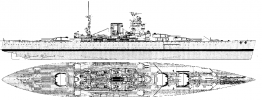The 6” turrets were overweight. They were originally supposed to be 48 tons. This got pushed to 60, and they eventually came in at 77. 6” secondaries was, IMO, a mistake from Iron Duke to Nelson. A gun in the 4.5-5.5” range would likely have been better (the later 4.7” was 25 tons).
I think the 6in was carried because it was the armament of the last dreadnoughts, and was to provide stopping-power against light cruises (and destroyers). The AA doctrine of the time was barrage fires, so a uniform secondary battery of a lighter caliber could have provided a good barrage for AA work as well as a volume of fire for fending off light forces.
I've often wondered of the seeming schizophrenia of the largest navy in the world worried about its capital ships being without escort. "A turret must be able to fire at zero degrees elevation dead ahead" the heavier secondaries like the 5.25in for 'anti-cruiser' work. I can think of only two occasions where an allied battleship was alone without escort in hostile waters with a chance of meeting enemy light forces (cruiser or smaller);
King George V during the
Bismarck chase, when the rest of the fleet departed for Iceland to refuel and
Washington during Second Guadalcanal. We could throw in
Hood and
Prince of Wales at Denmark Straight as well, but that was a conscious choice by Holland to send all his escorting destroyers north to search for the enemy.
I’m honestly surprised they weren’t ditched in a refit and replaced w/ 4.5 inch, 4.7 inch or the 5.25.
As I recall, the proposed rebuild of Rodney was to include a cross-deck catapult and changing the 6in and 4.7in for eight 5.25in. There was also a plan to rearm
Nelson with 5in/38s before the US entry into the war ended the project.
That's not major ship surgery, but it's significantly more work than with the old-school casemates. The Brits couldn't even find the time to keep Rodney's machinery in decent condition. Replacing the secondaries was assuredly very low down their list of priorities.
Overtaken by events. The second half of the '30s saw Europe lurch from one crisis to another, the Spanish Civil War, the Abyssinian Crisis, the annexation of Austria, the Sudetenland, etc. The largest and most powerful ships in the RN,
Hood, Nelson and
Rodney were very much in demand. And
Nelson and
Rodney were actually ahead of
Hood in the rebuild schedule because of the pathetic state of their electrical systems.
My thoughts,
